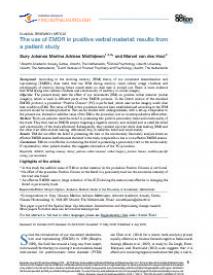The use of EMDR in positive verbal material: results from a patient study
Background: According to the working memory (WM) theory of eye movement desensitisation and reprocessing (EMDR), dual tasks that tax WM during memory recall reduce image vividness and emotionality of memory during future recalls when no dual task is carried out. There is some evidence that WM taxing also reduces vividness and emotionality of auditory or verbal imagery.
Objective: The present study tests the effect of eye movements (EM) on positive verbal material (verbal imagery), which is used in different parts of the EMDR protocol. In the Dutch version of the standard EMDR protocol, a procedure “Positive Closure” (PC) is performed, which uses verbal imagery under dual task condition (EM). The value of EM in this procedure has not been established and according to the WM account would be counterproductive. Two earlier studies with undergraduates, with a set-up comparable to the present one, showed no additive value of the EM in the procedure, but no counterproductive effect either.
Method: Thirty-six patients rated the belief in possessing two positive personality traits and emotionality of the traits. They then had an EMDR session targeting a negative memory and recalled and re-rated the belief and emotionality of the traits afterward. Subsequently, they recalled one trait while dual tasking (EM) and the other trait without dual tasking. Afterward, they re-rated the belief and emotionality.
Results: EM did not affect the belief in possessing the trait or the emotionality. Secondary analysis shows an effective EMDR session itself enhances the belief in the traits, compared to a less or non-effective EMDR session.
Conclusions: EM are not effective in enhancing the belief in possessing a personality trait or the emotionality. If replicated by other patient studies, this suggests elimination of the PC procedure.
In: European journal of psychotraumatology, ISSN 2000-8066 | 7 | 30119
http://www.ejpt.net/index.php/ejpt/article/view/30119


